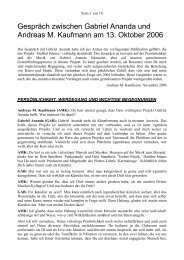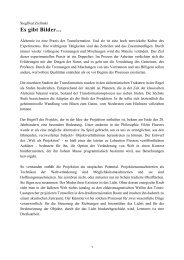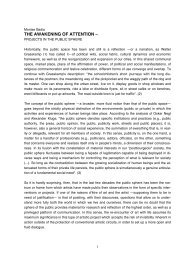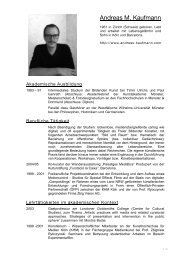Text_Catalogue_EN Roland Scotti - Andreas M. Kaufmann
Text_Catalogue_EN Roland Scotti - Andreas M. Kaufmann
Text_Catalogue_EN Roland Scotti - Andreas M. Kaufmann
You also want an ePaper? Increase the reach of your titles
YUMPU automatically turns print PDFs into web optimized ePapers that Google loves.
If Art were Art and the World the World, Everything Would Be Good<br />
<strong>Andreas</strong> M. <strong>Kaufmann</strong> and Meaning of the Image Machine<br />
<strong>Roland</strong> <strong>Scotti</strong><br />
In an interview with Gene Swenson, What is Pop Art? Answers from 8 painters, published<br />
in the American art journal Art News in 1963 (Vol. 62, November), Andy Warhol<br />
maintained at several points that is was desirable (for him) to be a machine: “Everybody<br />
looks alike and acts alike, and we’re getting more and more that way. / I think everybody<br />
should be a machine. I think everybody should like everybody,” “The reason I’m painting<br />
this way is that I want to be a machine, and I feel that whatever I do and do machine-like is<br />
what I want to do.” This initially innocent equating of artistic creativity with a machine-like<br />
or technoid process then ended with the summing up: “Machines have less problems. I'd<br />
like to be a machine, wouldn't you?”<br />
The question is not new in itself – neither in society nor in the realm of art. In sociology<br />
there is the concept of the megamachine, which was coined by the historian, philosopher,<br />
and sociologist Lewis Mumford in his major work, The Myth of the Machine (New York,<br />
1974). In this concept, the work slaves of antiquity and the soldiers of the modern age<br />
were part of a machine-like mechanism, in that they functioned like machines – or simply<br />
did not function. In art, “the machine” has played an ambivalent role at least since Filippo<br />
Marinetti’s manifesto Le Futurisme (Le Figaro, Paris, February 20, 1909). The manifesto,<br />
which can be received in its enthusiasm for technology and contempt for mankind both as<br />
a foreshadowing of World War I and also as a pre-fascistic raving, ultimately harmlessly<br />
initiated a discussion of the relationship of art, technology, and machine as a hermetic,<br />
aesthetic field: ex negativo in the case of realist art movements, positively in the case of<br />
avant-garde positions such as Constructivism, Bauhaus, Surrealism, etc.<br />
The concept of machine art can also be dated to the period after World War I, when it was<br />
first used in in connection with the Soviet Proletkult in a sense of believing in the future,<br />
and by Constructivists such as Naum Gabo, Laszlo Moholoy-Nagy, or Vladimir Tatlin: the<br />
new man should serve the new machines. Starting in the mid-1950s, this arguably<br />
somewhat inhuman sounding concept was reinterpreted into that of the art-machine. It was<br />
possible alone in Switzerland for artists such as Jean Tinguely or Bernhard Luginbühl to<br />
cast a positive light on the term “machine art” – perhaps because they always allowed the<br />
destructive powers of the apparatuses to play a role. Otherwise the art-machines, when<br />
they were not used to produce art themselves (or the appearance of art), were mostly to<br />
be found in the surroundings of the kinetic arts – as in the case of George Rickey or Julio<br />
Le Parc, although the machine-like was often limited here to the motor-operated.<br />
Yet behind all of these aesthetic machines still always remained the concept that had<br />
shaped the idea of machines since the beginning of the industrial revolution: the massive,<br />
iron monstrosity that hissing and spitting transformed the world – congenially demonized in<br />
Fritz Lang’s film Metropolis (1927). The art-machine (and thus also the human-machine)<br />
was a robot that, like artists, craftsmen, etc., transformed materials.<br />
Yet since 1837, a quite different machine has also existed, which considerably smaller and<br />
finer, was supposed to change not the form of the world but rather the perception of the<br />
world: the camera. With photography, reproduced images became the real world, and the<br />
world we perceive results from the interpretation of these images. What had first been<br />
Seite 1 von 5
conceived as an objectivist light drawing of reality became an optical apparatus, which at<br />
the latest with the invention of roll film (1888) and the compact camera (1913) altered not<br />
only the documentary but also the aesthetic view of the world – as a mass image that is<br />
simultaneously objective as well as highly individualistic. This machine, which can be<br />
carried in the hand, called fine art into question in its very own field, the production of<br />
images to be seen consciously – since with the photographic technology, one could –<br />
although still manually, yet without traces of a signature – draw an image of the world in<br />
which even the most banal still seemed and seems interesting. Photography brought – in<br />
combination with print media, slideshows, films, videos – a flood of images that fascinated<br />
and captivated both the private and the public eye, a mountain of images that can have a<br />
consciousness-raising effect but often, however, as a noise of images, is also only<br />
consciousness-steering or even contributes to a clouding of consciousness. It sometimes<br />
seems as if there might be more photos and films than world, as if reality were absorbed<br />
into the optical user interface of digital systems, from the PC to the photo cellphone to the<br />
iPad, which are in the end also only a further development of the camera – enriched with<br />
communicative and interactive possibilities that transpose seeing into doing.<br />
Perhaps this is the machine that Andy Warhol would have liked to be: the absolutely<br />
soulless, image-producing machinery for which everything is equally good and equally bad<br />
– for which the visible and sensually perceivable reality is always already fixed, is<br />
“somehow” no longer memory that can be interpreted?<br />
<strong>Andreas</strong> M. <strong>Kaufmann</strong> analyzes and interprets machines, above all the photographic<br />
apparatus, and thus images generated by means of analogue or digital techniques, which<br />
he sometimes presents as fragments of meaning, sometimes, in turn, deconstructs as<br />
units of meaning, or also at times stages as pure presence, as pure beauty, as a sensual<br />
phenomenon. He wants – clearly – not only to exploit the indifference of the MACHINE but<br />
to overcome through utilizing, to give meaning to the process of producing and seeing<br />
images, not an authoritarian, fixed, or decreed meaning but rather a meaning that calls into<br />
question the visible and what can be read in seeing. It is, therefore, natural that <strong>Kaufmann</strong><br />
also deals with language, with published words, slogans, etc., as images. Words like<br />
images first become manifest through (artistic) interpretation, through aesthetic and critical<br />
treatment of them – become more than that which we observe with “disinterested<br />
pleasure,” can enjoy and forget. This – the insistence on inventing meaning through art –<br />
is not simple, and even in a certain way, permanently bound to fail, since every image,<br />
every interpretation of an image, every word, every sentence contributes to the<br />
redundancy of the optical – or not, as should be demonstrated what follows.<br />
Showing, the how and why of showing are fundamental problems addressed in<br />
<strong>Kaufmann</strong>’s art. In the early work created at the end of his art studies, Kleine<br />
Kunstgeschichtsmaschine (Little Art History Machine, 1991; installed site-specifically<br />
numerous times since then), <strong>Kaufmann</strong> already defines his art as a showing, an alluding<br />
to, as an intervention in predefined nexuses that brings light, that illuminates the structural<br />
or the historical, that continues, transforms, and re-contextualizes artistic genres and<br />
traditions such as drawing, gesture, the guiding of the eyes, spatial composition in and<br />
with the medium of “light.” With the Kleine Kunstgeschichtsmaschine, which is not really<br />
that small since the projection of the fingers drawn in light and captured on a slide are<br />
adapted to the dimensions of each particular space.<br />
The motif that the viewer sees at first glance is a drawn reproduction, a visual quotation of<br />
the hand of God from Michelangelo’s The Creation of Adam, a detail of the fresco on the<br />
ceiling of the Sistine Chapel in the Vatican. In this detail is captured that decisive moment<br />
shortly before God brings his creation to life through touch, gives him a soul, sensuality,<br />
Seite 2 von 5
and meaning. <strong>Kaufmann</strong> communicates this moment to our perception by means of a<br />
“little” gimmick. In that we follow the finger, which seems naturalistic in one moment,<br />
fragmented or abstract in another, with our eyes, we are able – when we do not then look<br />
like idiots at the finger instead of at the moon – to discern what is touched by the trail of<br />
light, whether a thing, a plant, a piece of architecture, a word, a person, or also a thought.<br />
Since the quotation from art history that the artist brings up-to-date in his slide projection,<br />
is not meant to be seen as a work that rests in itself, as a self-referential work, but rather<br />
as an energy field that – in the best case – animates what is already there as a form with<br />
meaning. Essentially, <strong>Kaufmann</strong> shows what Michelangelo left out of the fresco, the light<br />
or the vitalizing energy that flows from the finger of God into the puppet of flesh “Adam”<br />
and makes him into the thinking, feeling, and dreaming human being.<br />
The Kleine Kunstgeschichtsmaschine can, however, also be read as a programmatic<br />
statement by the artist: <strong>Andreas</strong> M. <strong>Kaufmann</strong> is not concerned with inventing or finding<br />
new images. He is rather concerned with creating unique constellations in which old,<br />
already existing images connect with a concrete topographical situation or a specially<br />
erected spatial structure to form a visual unit – a unit that, in our process of perception,<br />
can lead to a sensory insight – particularly when we see ourselves as part of the work.<br />
While it was still possible in the case of the Kleine Kunstgeschichtsmaschine to maintain a<br />
distance, to be able to remove oneself from the overall image, this was no longer possible<br />
in the case of <strong>Kaufmann</strong>’s second programmatic work, the Grosse<br />
Kunstgeschichtsmaschinerie (Large Art History Machinery, starting in 1992). When the<br />
multipartite installation of slide projectors (7 projectors with 280 image reproductions<br />
based on works by 40 artists) is set up, the viewer stands in the swirl of images, which<br />
consists of an infinite number of combinations of images, superimpositions of images,<br />
constructions of images, and spatial images. Although viewers interested in art are<br />
arguably able to recognize and name the majority of the artworks utilized since they are<br />
part of the incunabula of the history of art from Giotto to Roy Lichtenstein, the longer they<br />
stay in the installation, the more they lose the overview. Not only the light of the works<br />
pictured is overlaid, the chronology of the history of art, the linearity of the writing of the<br />
history of art is pushed through the image mixer, the structures of the space in which it all<br />
takes place dissolve, everything becomes the image carrier, everything turns into an<br />
image – into an image that asserts that in art, the history of humankind is simultaneously<br />
suspended and dissolved. The nature of the artwork – of every work that has a fixed form<br />
– becomes apparent: art, whether it is old or current, always constitutes present, is<br />
constantly in the mode of the present. When one views art, one ultimately observes all<br />
ages, at least those in which human consciousness and the human creative will played a<br />
role, at the same time. And therefore, namely in that it makes this idea into an optical<br />
experience, the Grosse Kunstgeschichtsmaschinerie becomes a monument to cultural<br />
memories, that “world soul,” that “tradition in us, the texts, images and rituals that have<br />
solidified over generations, in centuries-long, indeed millennia-long repetition, that shape<br />
our awareness of time and history, our view of ourselves and of the world” (Jan Assmann,<br />
Das Kulturelle Gedächtnis, in: Jan Assmann. Thomas Mann und Ägypten, Mythos und<br />
Monotheismus in den Josephsromanen, Munich 2006, p. 70). The Grosse<br />
Kunstgeschichtsmaschinerie shows not only this cultural imprint – this is also done by<br />
every cultural museum – it showcases what it means to move in a space of the most<br />
diverse and contradictory impressions.<br />
Conceptually, with these two light and projection works, <strong>Kaufmann</strong> not only took leave of<br />
his academic, artistic training but also laid the foundation for his further work on the Veil of<br />
Maya: the question of whether there is something concealed behind what we perceive that<br />
Seite 3 von 5
is actually beyond our perception. This is a philosophical-existential question that, in my<br />
opinion, accompanies the artistic work of <strong>Andreas</strong> M. <strong>Kaufmann</strong> as a whole and that he<br />
shapes into the most varied of forms.<br />
If one wanted to construct a line of tradition for <strong>Kaufmann</strong>, which today, in “networked”<br />
times in which everyone refers to everything and everyone, is presumptuous, then one<br />
would have to name, in addition to artists such as Moholy-Nagy, Jean Tinguely, Heinz<br />
Mack, François Morellet, Bruce Naumann, Joseph Kosuth, Jenny Holzer, Nan Hoover (to<br />
mention only those from the field of light art), above all aesthetes, philosophers, cultural<br />
scientists, et al – whereby here the emphasis would be placed on the epistemologist, the<br />
phenomenologists, and scholars in the field of the Bildwissenschaft of today. This would<br />
only be fitting – some of the titles that <strong>Kaufmann</strong> gives his works also support this – and<br />
yet in the same breath also an overloading of the artistic work as well as perhaps an<br />
overtaxing of the those who receive the art, since the assertion “I can because I want what<br />
I must,” as <strong>Kaufmann</strong> declared in one of his most recent installations, does not apply to<br />
every viewer. This paraphrasing of this much cited credo attributed to the philosopher<br />
Arthur Schopenhauer and supposedly circulated by Albert Einstein “A man can do what he<br />
wants, but not want what he wants,” sounds – when taken out of the artistic context and<br />
placed into the context of my essay – as if it might be a work motto of the artist: <strong>Andreas</strong><br />
M. <strong>Kaufmann</strong> can organize the images of the world because he wants to and/or has come<br />
to the opinion that someone has to take upon themselves the Sisyphean task of<br />
preserving, organizing, classifying the worlds of images and world images – or also only to<br />
make them available within another context than that of the encyclopedia, the anthology,<br />
the print media, catalogues, television, the Internet, and to make them the basis or the<br />
impetus for a hopefully endless discourse about the histories of ideas (not the ideologies)<br />
of human civilization. For the artist, images and, in the meantime, also words, are<br />
attestations to those ideas that create, transform, reinvent – and sometime arguably also<br />
destroy – the world.<br />
In contrast to the innocence of artworks, ideas can be quite dangerous. In the third large<br />
work to be shown in the Kunsthalle Ziegelhütte, <strong>Kaufmann</strong> makes these thoughts, this<br />
conjecture become apparent: Innocent Colors consists of monochrome color panels that<br />
are perforated with words and sentences, which at one moment seem quite decorative and<br />
at another have a quite eerie effect. The installation might call to mind Gerhard Richter’s<br />
atlas of colors, the series of Color Panels which he has continuously been painting since<br />
1966 and that incorporate the presentation of industrial color charts as a possibility into<br />
painting. But <strong>Kaufmann</strong> has this innocent colored skin pierced with holes, cut and drilled<br />
through – the empty spaces are filled with the light of the image carrier, usually a white<br />
wall. The holes, which are sentences collected from newspapers and magazines and other<br />
medial testimonies, which are intrinsically innocent since they are without context. Whether<br />
they are more innocent than the epigram “Arbeit macht frei” is something that will first be<br />
revealed by history.<br />
Alone this, my associations allows me to draw the conclusion, the fact that <strong>Kaufmann</strong>’s<br />
experimental and conceptual artistic work is not aimed exclusively at the aesthetic space<br />
but rather consciously involves an ethical dimension. <strong>Kaufmann</strong>’s “works” are always also<br />
decisions for a particular material, for a content that more or less wants to be examined<br />
and has to be examined, or as he himself formulated in an artist’s statement: “In addition,<br />
art can help people to discover connections and structures in their increasing complex<br />
lives. It does this when it stimulates attention and reflection by means of direct experience,<br />
and in that it deals above all with such contents and realities that are suppressed in the<br />
public awareness of bourgeois civilization, or have been misused or whose meaning has<br />
Seite 4 von 5
ecome distorted. In this sense, art is sustenance for society just like food and drink are<br />
for the individual. It reminds us of the vital importance of constantly learning more on a<br />
broader basis, passing on what is learned, and remaining intellectually flexible”.<br />
All of the works that are presented in this publication as exhibition works or as cursory<br />
work documentation – Kleine Kunstgeschichtsmaschine (since 1991), Grosse<br />
Kunstgeschichtsmaschinerie (1992), The Living Book (2010), Innocent Colors (2011),<br />
Pausenprojekte: Lichtpause (2004), Bilderpause (1996/2000) and Denkpause (2000),<br />
Blind Man Walking (1996), Ich kann, weil ich will, was ich muss (2005 – 2010), In memory<br />
of … (2008/2009), Neither Body Nor Soul (2005/2006), No Agreement Today, No<br />
Agreement Tomorrow (2004 – 2028), The Book Project (2002 – 2005), Ortlos (1996) – are<br />
results of an artistic search that is simultaneous both research and exploit. It is research<br />
because <strong>Kaufmann</strong> observes, forms, and transforms the limitations, the conditions, the<br />
prerequisites, the historical implications, and so on of seeing and reading, of the basics of<br />
understanding methodically, in the sense of the humanities, although not necessarily<br />
systematically in a scientific sense. His works are to be understood as a sensual question<br />
mark able to be experienced with the senses, which he sets in our everyday reality<br />
spaces. Exploit, because it is already an achievement to continue to pose the question of<br />
the meaning of the visual, the acoustic, the lexical, the emotional at all – and this “matterof-factness”<br />
in a time filled with an insensible stream of images and ever-present blabbing<br />
can perhaps also be interpreted as an “exploit,” as exploitation of the security gaps and<br />
dysfunctions in habitual mechanisms of perception, thought patterns, and interpretations of<br />
reality.<br />
The world does not become simpler and especially not better through art or culture, just as<br />
art or culture do not become better and especially not simpler through the world. In the<br />
best case, memory of the respective other shines forth in both of them – <strong>Kaufmann</strong> works<br />
with a form of Mnemosyne on the “best case,” on the intrinsic value of memory and of<br />
belief.<br />
Translated from German to English by Amy Klement / Berlin<br />
Seite 5 von 5







